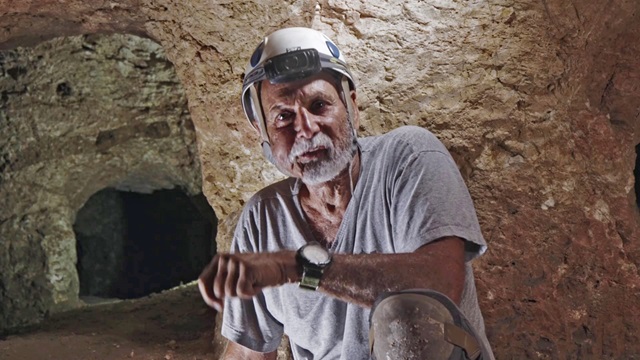
Professor Yinon Shivtiel at the hiding complex. Photograph_ Emil Aladjem, Israel Antiquities Authority.
What is being called the “most extensive hiding complex” discovered to date, one from the period of the Bar Kokhba Revolt against the Roman Empire was uncovered near the Sea of Galilee at the site of Huqoq. It was revealed in an archaeological excavation carried out by the Israel Antiquities Authority (IAA), with the help of hundreds of school and university students, soldiers, and volunteers.
The IAA said this excavation uncovered finds that reveal “dramatic episodes in the history of the Jewish people.”
This is the second such archeological find related to the Bar Kokhba Revolt uncovered so far in the month of March. Israeli archeologists also uncovered a rare coin from the time of the era engraved with the name of “Eleazar the Priest” in ancient Hebrew script. The coin is dated to the first year of the revolt, 132 CE and was discovered with three other coins from the time of the Revolt in the Mazuq Ha-he’teqim Nature Reserve in the course of the Judean Desert Cave Survey carried out by the Israel Antiquities Authority.
Will you offer us a hand? Every gift, regardless of size, fuels our future.
Your critical contribution enables us to maintain our independence from shareholders or wealthy owners, allowing us to keep up reporting without bias. It means we can continue to make Jewish Business News available to everyone.
You can support us for as little as $1 via PayPal at office@jewishbusinessnews.com.
Thank you.
The Bar Kokhba Revolt (132–135 CE) was a large-scale armed rebellion by the Jews of Judea against the Roman Empire. It was the third and final major Jewish–Roman war, following the First Jewish–Roman War (66–70 CE) and the Kitos War (115–117 CE).
The excavation also revealed that, as part of the preparations for the First Revolt in 66 CE and the Bar Kokhba Revolt in 132 CE, the residents of Huqoq converted the water cistern (dug in the Second Temple period) into a hiding complex. In addition, at the time of danger, they broke one of the walls of the mikveh (ritual bath) and dug a tunnel into other cavities. Several tunnels allowed maneuvering in narrow low spaces underneath the houses.
In this underground system, there are about eight hiding cavities, and the connecting tunnels are dug at 90 degrees, to hamper the heavily armed Roman soldiers chasing the rebels. The excavation also yielded hundreds of broken clay and glass dishes, an impressive ring for a precious stone (the stone itself was not found), and other fascinating finds.
Huqoq is known as a Jewish town from the Early Roman period, about 2,000 years ago. The Jerusalem and Babylonian Talmuds mention Rabbi Pinhas and Rabbi Hezekiah, sages from the third and fourth centuries CE, who were based in the area. On the hilltop, near the hiding complex, a synagogue with impressive and unique mosaics, dating to the Byzantine period was discovered. The synagogue was dug since 2011 by an expedition from North Carolina University, headed by Professor Jodi Magness.
“We turned the excavation in the hiding complex into a community excavation as part of the Israel Antiquities Authority’s vision of connecting the public to its heritage,” says Dr. Einat Ambar-Armon, director of the Israel Antiquities Authority Archeological-Educational Center in the Northern Region. “The excavation brings together school students studying the Land of Israel and Archaeology, students from the Zefat Academic college, volunteers from the Israel Cavers Club, local volunteers, and even soldiers from the IDF Samur Unit of underground operations, who utilize their skills for this important goal.”
“The hiding complex provides a glance on a tough period of the Jewish population in Huqoq and in the Galilee in general,” say the excavation directors, Uri Berger of the Israel Antiquities Authority and Prof. Yinon Shivtiel of the Zefat Academic College. “However, the story that the site tells is also an optimistic story of an ancient Jewish town that managed to survive historical tribulations.” They add that “it is a story of residents who, even after losing their freedom, and after many hard years of revolts, came out of the hiding complex, and established a thriving village, with one of the most impressive synagogues at the area.”
The archeologists explained that the discovery of the hiding complex this far north can also contribute to a decades-long debate among researchers on whether the Bar Kokhba Revolt reached the Galilee or remained within the confines of Judea and central Israel. Based on different findings, Berger and Shivtiel date the inner parts of the hiding complex to the days of the outbreak of the Second Revolt and consider that several of the ancient facilities were first in use during the First Revolt. “It is not certain that the complex was used for hiding and escaping during the Second Revolt, but it does appear to have been prepared for this purpose,” they say. “We hope future excavations will bring us closer to the answer.”



